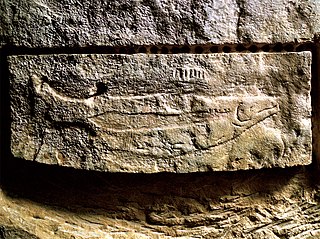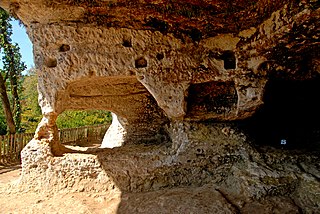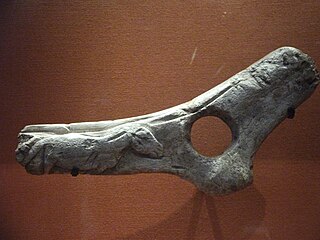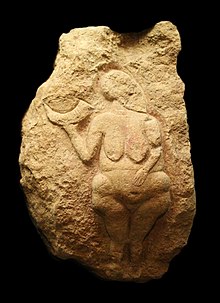
The Paleolithic or Palaeolithic, also called the Old Stone Age, is a period in human prehistory that is distinguished by the original development of stone tools, and which represents almost the entire period of human prehistoric technology. It extends from the earliest known use of stone tools by hominins, c. 3.3 million years ago, to the end of the Pleistocene, c. 11,650 cal BP.

Cro-Magnon is an Aurignacian site, located in a rock shelter at Les Eyzies, a hamlet in the commune of Les Eyzies-de-Tayac-Sireuil, Dordogne, southwestern France.

A Venus figurine is any Upper Palaeolithic statue portraying a woman, usually carved in the round. Most have been unearthed in Europe, but others have been found as far away as Siberia and distributed across much of Eurasia.

The Gravettian was an archaeological industry of the European Upper Paleolithic that succeeded the Aurignacian circa 33,000 years BP. It is archaeologically the last European culture many consider unified, and had mostly disappeared by c. 22,000 BP, close to the Last Glacial Maximum, although some elements lasted until c. 17,000 BP. In Spain and France, it was succeeded by the Solutrean, and developed into or continued as the Epigravettian in Italy, the Balkans, Ukraine and Russia.

Les Eyzies-de-Tayac-Sireuil is a former commune in the Dordogne department in Nouvelle-Aquitaine in southwestern France. On 1 January 2019, it was merged into the new commune Les Eyzies.

The Upper Paleolithic is the third and last subdivision of the Paleolithic or Old Stone Age. Very broadly, it dates to between 50,000 and 12,000 years ago, according to some theories coinciding with the appearance of behavioral modernity in early modern humans, until the advent of the Neolithic Revolution and agriculture.

Paleolithic religions are a set of spiritual beliefs and practices that are theorized to have appeared during the Paleolithic time period. Paleoanthropologists Andre Leroi-Gourhan and Annette Michelson believe unmistakably religious behavior emerged by the Upper Paleolithic, before 30,000 years ago at the latest, but behavioral patterns such as burial rites that one might characterize as religious — or as ancestral to religious behavior — reach back into the Middle Paleolithic, as early as 300,000 years ago, coinciding with the first appearance of Homo neanderthalensis and possibly Homo naledi.

La Gonterie-Boulouneix is a former commune in the Dordogne department in Nouvelle-Aquitaine in southwestern France. On 1 January 2019, it was merged into the commune Brantôme en Périgord.

Roc-aux-Sorciers is an Upper Paleolithic rock shelter site dating to the mid-Magdalenian cultural stage, ca 14,000 yBP, made famous by its relief wall carvings. The site is in the French commune of Angles-sur-l'Anglin, in Vienne. The name 'Sorcerers' Rock', with its suggestions of pagan rendez-vous, was applied to the site long before the wall-carvings were discovered.

Bison Licking Insect Bite is a prehistoric carving from the Upper Paleolithic, found at Abri de la Madeleine near Tursac in Dordogne, France, the type-site of the Magdalenian culture, which produced many fine small carvings in antler or bone.

Aadloun, Adloun or Adlun is a coastal town in South Lebanon, 17 kilometres (11 mi) south of Sidon famous for its cultivation of watermelons. It is also the site of a Phoenician necropolis and prehistoric caves where four archaeological sites have been discovered and dated to the Stone Age. The evidence of human occupation of Abri Zumoffen has been dated as far back as 71,000 BCE with occupation of Bezez Cave dating back even further into the earlier Middle Paleolithic.

The Prehistoric Sites and Decorated Caves of the Vézère Valley is a UNESCO World Heritage Site in France since 1979. It specifically lists 15 prehistoric sites in the Vézère valley in the Dordogne department, mostly in and around Les Eyzies-de-Tayac-Sireuil, which has been called the "Capital of Prehistory". This valley is exceptionally rich in prehistoric sites, with more than 150 known sites including 25 decorated caves, and has played an essential role in the study of the Paleolithic era and its art. Three of the sites are the namesakes for prehistoric periods; the Micoquien, Mousterian, and Magdalenian. Furthermore, the Cro-Magnon rock shelter gave its name to the Cro-Magnon, the generic name for the European early modern humans. Many of the sites were discovered or first recognised as significant and scientifically explored by the archaeologists Henri Breuil and Denis Peyrony in the early twentieth century, while Lascaux, which has the most exceptional rock art of these, was discovered in 1940.

The archaeological site Abri de la Madeleine is a rock shelter under an overhanging cliff situated near Tursac, in the Dordogne département of the Aquitaine région of southwestern France. It represents the type site of the Magdalenian culture of the Upper Paleolithic. The shelter was also occupied during the Middle Ages. The medieval castle of Petit Marsac stands on the top of the cliff just above the shelter.

Laugerie-Basse is an important Upper Paleolithic archaeological site within the territory of the French commune Les Eyzies-de-Tayac-Sireuil in Dordogne. It is known for several works of art from the Magdalenian. In 1979, Laugerie-Basse, along with other nearby paleolithic sites, was inscribed on the UNESCO World Heritage List as Prehistoric Sites and Decorated Caves of the Vézère Valley.

An example of the art of the Upper Paleolithic in the Last Glacial Period, this decorated fragment of a perforated antler baton was discovered in 1863 by Edouard Lartet and Henry Christy at the Abri de la Madeleine, an overhanging cliff situated near Tursac, in the Dordogne département and the Aquitaine Région of South-Western France. This is the type-site for the Magdalenian culture, currently dated to around 17,000 to 12,000 years ago. It was bequeathed to the British Museum by Christy, and is now catalogued as Palart.310, but not normally on display.

L'Abri Pataud, or the Pataud Shelter in English, is a prehistoric site found in the middle of the village Les Eyzies-de-Tayac-Sireuil in Dordogne, Aquitaine, southwestern France. The site includes human remains, stone tools, and early cultural artifacts made during the Upper Paleolithic, between approximately 47,000 and 17,000 years ago.

The abri de Cap Blanc is a prehistoric limestone rock shelter with Magdalenian animal sculptures. It is in the Marquay commune on the right bank of the Beune River, a few kilometers west of Eyzies-de-Tayac, in Dordogne.

The National Museum of Prehistory is a French institution founded in 1918 by Denis Peyrony in the commune of Les Eyzies-de-Tayac, in the Dordogne. Officially inaugurated on September 30, 1923, it is housed in what was formerly the Château de Tayac, purchased for this purpose by the State in 1913. In 2004, a new museum, designed by Jean-Pierre Buffi, was inaugurated on the emblematic cliff face of Les Eyzies.
The Monpazier Venus, also known as the "Vénus de Monpazier," is a small, prehistoric figurine of a female form that was discovered in Monpazier, a medieval town in the Dordogne region of southwestern France. It was found accidentally in 1970 outside of its archaeological context. However, it has been dated by comparison with other female figures found in Europe.. This figurine is an example of Paleolithic art, specifically from the Gravettian period, which is estimated to have occurred around 22,000 to 28,000 years ago.




















